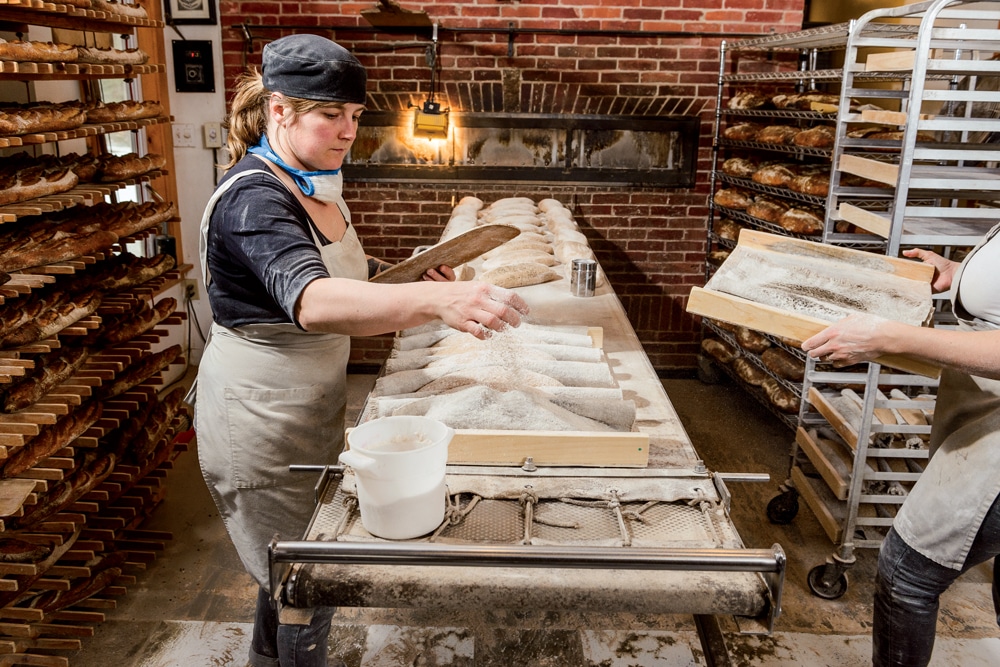Breads
On the Rise | The “Grainiacs” of Vermont’s Elmore Mountain Bread
A cadre of New England wheat growers and artisan bakers who proudly call themselves “grainiacs” are creating some of the best breads in the country.

Coffee By Design | Portland, Maine
Photo Credit : Katherine Keenan







Do any of these bakers sell on-line?? How would I/we get some of this delicious bread in Naples FL ??? We desperately need someone to open a bakery with 100% artisan bread!!
I meant to give your article 5 stars, but somehow it showed up as 3. Sorry 🙁 Very cool article. Seems like this industry is on the edge of breaking out, much like the microbrewery industry was a few decades ago. I can see this evolving into something similar to wineries where it’s not only the winery being important, but the vineyard, too. Besides the anticipated improved taste, I have a daughter with celiac disease, and I’d like to see if this bread affects her like breads made using modern milling, assuming she’d be willing to be part of this experiment. We’ll be travelling in Vermont in Oct, and am interested in trying this for myself. Thanks!
Fabulous article about fabulous people engaged in restoring balance, health, and interest to, and in, our ‘daily bread.’ I thank you so much for this information. I would also like some further pointers on the ‘gluten’ issue, with specific health information if you know where to find it, as to the unnatural over-hybridization of modern wheat, if it is indeed the major cause of increased gluten sensitivity and digestive challenges. Thank you, Henry
Good journalism is as rare as good bread. I relished your artful words, colorful descriptions, and humor that connected me to the story. I subscribed!!
What a great, inspiring, and well-written article! It motivated my friend and me to drive to Elmore to buy bread supplied to the local market by the bakery. The writer wasn’t kidding: the bread was, indeed, redemptive. My friend, Connie, and I decided to head up into the hills to find the bakery and, now, mill manufacturer. We just wanted to take a look from afar. After much hunting and stopping for directions, we found it. The problem was that by the time we found it, we were hopelessly lost. We shamefacedly asked the man featured in your story for directions back to the highway — any highway. He generously offered to show us around and to explain their operation (that oven!) before helping us on our way. He couldn’t have been more kind.
Where can I get delicious bread in VT. Please publish a list for us bread lovers in the New England area!
Rowan’s story made me cry, for so many reasons. One for its inspiring message about real-life, courageous young New England doers who are giving back so much through their labors to all of us who live here, and most if all because they dared to be dreamers first. They are what it means to be Yankees, and it makes me proud to salute them. I also salute the exceptional writer who made me feel I was reading a love story I could not put down. I was. I cried because likely I will not live long enough to write in such a compelling way as that, though I might continue to try. But maybe Rowan does know the whole story not included here, of exactly how degraded — and degraded intentionally as part of the industrial, profit driven process most of feel we must accept — the white flour products we eat today actually are. The true story of the rise of why and how those big grain giants arose also needs to be told in detail, as part of the larger story of the global degradation of food that is ongoing wherever grains are grown in the developing world. I saw the rice-polishing machines coming into Bangladesh, because they were a source of income for small farmers. Finally, it has taken more than a century for US public health scientists to conclude that these commercial white flour baked goods most of us eat every day are actually harmful to our health when eaten regularly [ probably especially harmful to children, and women.} And in less than a decade these same manufacturers have added so much sugar to these products that it is now almost impossible to find a sugar-free breakfast food, or bread, or cracker, let alone one made from whole grains, even in so-called health food stores. Health experts call this practice “excess sugar,” and it is way ahead of gluten in its health-degrading potential, spread almost uniformly in most breakfast foods. Epidemic diabetes and pre diabetic conditions are only one result….The other story that needs telling is how, when immigrants from Eastern Europe were lured here to work in the textile and shoe factories, many of them managed to buy land and create farms modeled on those they knew as children growing up elsewhere. My grandparents were among them. They grew wheat, and oats and rye and many other grains for themselves and their animals, while the townspeople were proud to be eating white flour bread and cereal and crackers. Some of us are lucky enough to have eaten that fresh-grain food as children, and we can still remember their fragrant tastes. That memory also makes me cry…Finally, we need an Internet sign-up for these authentic contemporary grain foods to be distributed to every Meals-on Wheels in New England that can generate a demand for them. Kudos to Yankee for this kind of publishing, that my New England parents introduced me to during the its beginnings in the last century. NMS
Just wanted to drop a note. Not only is the topic very interesting, this is some of the best writing I have read in a very long time. Rowan, you have some impressive skills.
I loved reading this story!
I read this article when it came out last August and I had to find it again to show it to my daughter–in-law. It was just as inspiring a story the second time I read it. I am happy to have found a Brownfield, ME baker at our seasonal farmer’s market who makes real bread and what a difeernece it is. Keep up the great articles, Yankee.
I want to know if you ship your bread or grain to California?
Well written article! I want some of that fresh baked bread! So proud of these entrepreneurs!!
Enjoyed the article. Nice to know someone else thinks the bread of today is pretty awful…
Where can I buy the bread locally? Do you use soy in your bread. I am allergic to soy and cannot buy breads in the Sudbury, MA area.
Cora Marie Pustaver
So, two years later, why haven’t you replied to readers seeking to buy this wonderful bread?
Hi Joanne! All questions should be directed to Elmore Mountain Bread since they will likely be able to answer with more specificity. According to their website, the bread may be purchased at locations around Vermont.
When reading this article I cried with joy, hard lump in my throat for the care of our children.
Also I feel missing this news would be a shame for anyone- everyone’s future.
Grain harvested locally and used immediately what a lovely thought!
Great story,now, where can I get some of this bread. Love bread, need a address to order some loaves.